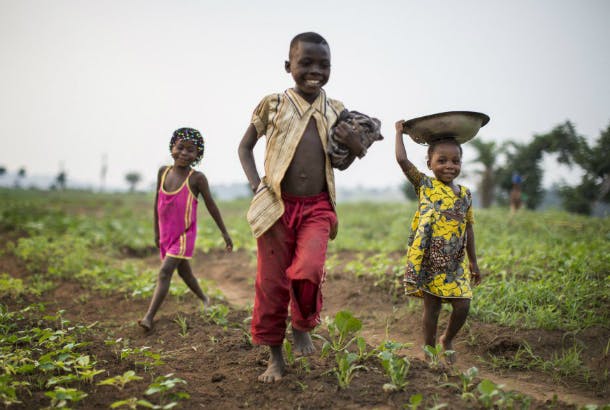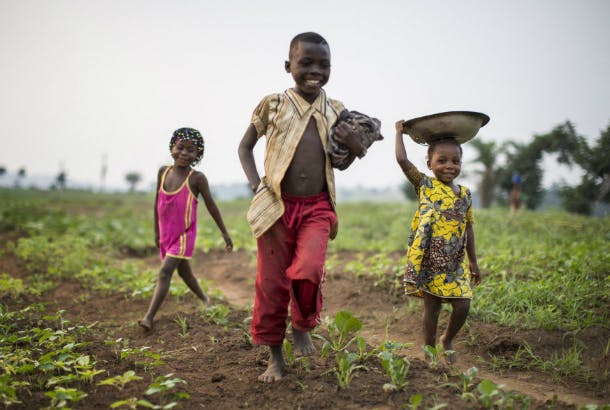
Although we may think about specific global issues like health, conflict, finance, and the environment as separate – and perhaps unrelated – challenges to be tackled independently, the reality is far from it. They are actually deeply connected, and our understanding, appreciation, and responses should be shaped accordingly.
The fundamental linkages among climate, development, and humanitarian action are apparent this week as the United Nations convenes multiple moments for global progress: the Financing for Development Forum (April 23-26), World Immunization Week (April 24-30), and the High-level meeting on Peacebuilding and Sustaining Peace (April 24-25). Many of us will have reflected on and celebrated the importance of continued climate action yesterday on Earth Day (April 22), and the UN Foundation and others will be elevating the important strides made, and progress still needed, on World Malaria Day (April 25).
Rather than seeing these moments as disparate efforts, we would be better served by looking at the common threads that run across each issue area to remind us of the need to consider holistic, integrated solutions to reach the world’s most vulnerable populations and address systemic issues threatening peace and prosperity.
The interconnectedness of these issues is at the heart of the Sustainable Development Goals (SDGs), which have been purposefully crafted to be inclusive and integrated across the social, economic, environmental, and governance fields.
It’s not by chance then that we see countries marred by conflict also suffering from devastating disease outbreaks, or places bearing the brunt of climate impacts likewise experiencing more acute levels of hunger or instability.
Of course, our ability to address these issues is directly correlated to our ability to mobilize resources at the scale needed. Current estimates suggest that achieving the SDGs will take between $5-7 trillion in annual investments – a figure that far exceeds current levels of official government aid and suggests the need for innovative new models of financing to fill the gap.
Closing this gap is critically important as progress in climate, development, and humanitarian issues spurs progress in other areas. Adversely, decline or stagnation can threaten broader progress. In all of this, having adequate resources – including financing – is key.
Global Challenges are Interconnected
Here are a few examples of where we see undeniable connections:
– Approximately 87% of people in extreme poverty live in countries that are fragile and/or are environmentally vulnerable. According to recent analysis by the UN Conference on Trade and Development, least developed countries (LDCs) – nations categorized by high incidence of poverty and economic vulnerability – will fall short of goals set out in the 2030 Agenda for Sustainable Development unless urgent action is taken. It’s not by chance these 47 countries are falling behind in crucial areas of peace, health, financial stability, and climate resilience.
– Nine of the 10 countries most affected by extreme weather events between 1997 and 2016 were developing countries. In many impacted regions reliant on farming, such as sub-Saharan Africa, communities struggle to recover from periods of extreme rainfall followed by extreme drought – extreme patterns that are becoming more common as a result of climate change. These climate-associated disasters triggered food crises in 23 countries and were responsible for pushing some 39 million people into acute food insecurity.
– Countries marred by devastating conflicts, such as Yemen, Myanmar, and South Sudan are the most vulnerable to hunger and disease, as they lack access to crucial health and financial services. Case in point: South Sudan and Yemen experienced severe outbreaks of cholera in 2017. Likewise, countries that lack the infrastructure to sustain resilient economies and health systems are far more susceptible to instability and conflict.
– A child in a developing country is 10 times more likely to die of a vaccine-preventable disease than a child from an industrialized one with proper health systems in place. Moreover, almost two-thirds of children who have not been immunized with basic vaccines live in countries that are either partially or entirely affected by conflict.
– The direct economic impact associated with violence and armed conflict accounted for 9.1% of global GDP in 2014 according to the Business and Sustainable Development Commission – a figure that rose to 13.3% of global GDP (approximately $13.6 trillion a year) in 2016, according to the Institute for Economics and Peace. These figures represent significant costs to the global economy that divert essential resources away from health, environmental, and peacebuilding needs.
Global Solutions are Interconnected, Too
Despite these enormous challenges, there are positive signals of progress. This week, let’s hope we find occasion to reinforce the integrated solutions needed across the development, humanitarian, and climate sectors from actors in the public, private, and civil society sectors.
For example, the recent UN-World Bank report, Pathways to Peace, identified a savings of up to $70 billion a year if the global community is able to implement a scaled-up system for prevention. These cost savings could be reinvested in reducing poverty, improving health, addressing climate change, and advancing prosperity
Look also at the African Capacity Insurance Company Ltd. – the first-ever African natural disaster insurance pool – which demonstrates how an innovative use of finance can improve current responses to weather-related food security emergencies, crucial to preventing instability and sustaining peace.
Following last week’s World Bank and IMF Spring Meetings in Washington D.C., let’s hope the conversation at the UN this week finds an opportunity to identify and strengthen innovative and crucial financial instruments such as the Pandemic Emergency Financing Facility and other efforts aimed at prioritizing human capital and universal health coverage for all.
In both the High-Level Meeting on Peacebuilding and Sustaining Peace and the Financing for Development Forum, tools like humanitarian impact bonds could be assessed as a way to raise ambition and accelerate our response to our interconnected challenges.
Beyond this important week, the momentum gained will set the pace for two major milestones for reviewing global progress – the High-level Political Forum in July, which this year will see country-level thematic reviews focused on climate and energy and the impacts across other SDGs and issue areas, and the UN General Assembly in September.
Bringing an intentional focus across and within these issues could strengthen the dialogues and anticipated impact happening this year, from climate change to security. And by drilling down on root causes, we can minimize knock-on effects across the security, development, and humanitarian agendas, and maximize scalable solutions.
It’s clear that we cannot escape the challenges of living in an interconnected world. To best leverage these synergies and make progress across our agendas, we need to break down silos and improve how we work together across issues and across sectors.

